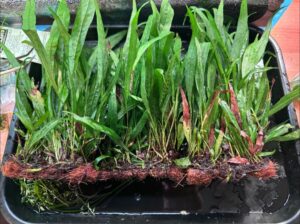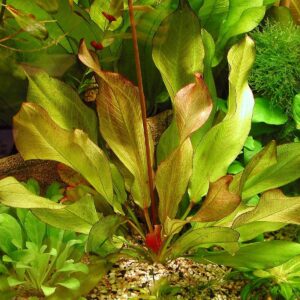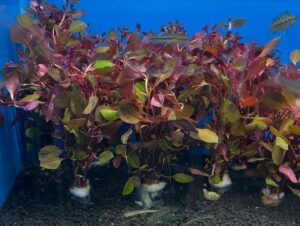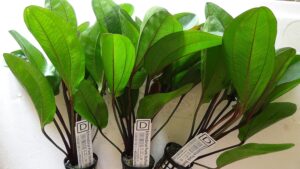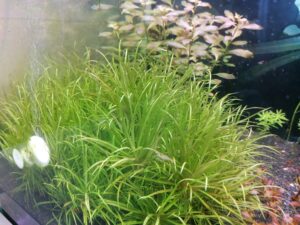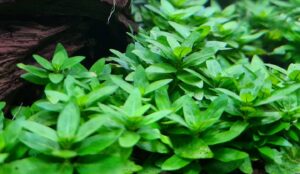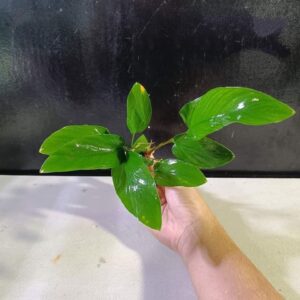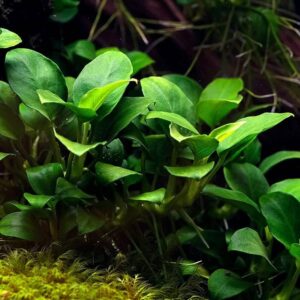Live plants not only enhance the natural beauty of your aquarium, but they also help maintain a healthy ecosystem and offer numerous benefits for your fish, including:
- Producing oxygen and absorbing CO2 during the day, which aids fish, supports filtration, and helps stabilize pH levels.
- Reducing algae growth by absorbing nitrate and phosphate from the water.
- Promoting fish health and vibrant colors by offering shelter and habitat, reducing stress, strengthening their immune systems, and encouraging them to stay out in the open where you can enjoy watching them.
- Providing a natural food source for fish that feed on microbes living on plant leaves, as well as those that graze directly on the plants.
- Offering spawning areas for many fish species and safe spaces for newly hatched fry.
Whether you’re adding a few plants for decoration or creating a full aquatic garden, understanding the needs of aquatic plants will ensure your aquarium thrives. To flourish, aquarium plants require:
- Clean, moderately soft water
- Full-spectrum lighting
- Adequate nutrients
- A suitable substrate for rooted plants
Aquarium Plant Water Requirements
Aquarium plants thrive best in water with a pH between 6.5 and 7.8, general hardness ranging from 50 ppm to 100 ppm, and alkalinity between 3° and 8° dKH (54 ppm to 140 ppm). Keep nitrates below 10 ppm and phosphates below 0.5 ppm to help prevent nuisance algae from growing on the leaves. The ideal temperature is between 74° and 80° F. Perform a 10% water change weekly or a 25% change every two weeks. To reduce organic pollutants that can tint the water and block light, use carbon or organic absorption resin in your filter. If your tap water isn’t suitable for plants, using reverse osmosis or deionized water is a must.
Good water circulation is also essential for plants. It ensures a steady flow of nutrients, helps inhibit algae growth, and prevents organic debris from collecting on the leaves.
Aquarium Plant Lighting Requirements
Selecting the right lighting for your planted aquarium depends on the plant species you want to grow and the height of your tank. Some plants require more intense light to thrive, and because light doesn’t penetrate water effectively, taller aquariums need a stronger light source. For the best results, aquatic plants should be illuminated under full-spectrum light with a Kelvin rating (color temperature) between 6,500K and 8,000K. Always choose lighting designed specifically for aquarium plants, as lights intended for houseplants may not have the proper Kelvin rating. High Output T5 fluorescent lights and LEDs are ideal choices for aquarium plants.
Be cautious when using “watts per gallon” as a measure of light requirements. This method was once useful when standard fluorescent lighting was the norm, but with the advent of High Output T5 and LED lighting, “watts per gallon” is no longer a reliable measure. Wattage indicates the amount of electricity a light uses, not its light output. Light intensity should be measured in lumens, and different types of lighting produce different amounts of lumens per watt. For example, a 60-watt incandescent bulb gives off fewer lumens than a 54-watt High Output T5 lamp, and you wouldn’t want to look directly into a 60-watt LED light! More meaningful measurements include lumens, PAR (photosynthetically active radiation), and PUR (photosynthetically usable radiation).
Aquatic plants generally require 10 to 12 hours of light per day. Extending light time won’t compensate for weak lighting. It’s also essential to maintain a consistent day/night cycle. If your light doesn’t have a built-in timer, use an external timer or digital power center to ensure consistency. To maintain optimal light output, replace High Output T5 and other fluorescent bulbs every 12 months. Lastly, keep glass covers clean to maximize light penetration.
Aquarium Plant Substrates
Selecting the right substrate is key for healthy root development and proper anchoring of rooted plants. Fine to medium-grade gravel or coarse sand work best, and mixing different grades can enhance both texture and aesthetics. Avoid ultra-fine sand and large gravel, as fine sand can compact and restrict oxygen flow, while coarse gravel may hinder root anchoring and trap excess organic debris. Aim for a substrate depth of 2″ to 3″, sloping it higher towards the back of the tank. Using terraces, hills, and valleys can add depth and dimension to your aquascape. Stay away from substrates made of dolomite, crushed coral, crushed oyster shells, or other calcium carbonate materials, as they can raise pH and alkalinity undesirably. Be sure to rinse your substrate thoroughly before adding it to the aquarium.
Aquarium Plant Nutrient Requirements
Aquatic plants require nitrogen, phosphorus, potassium, iron, magnesium, manganese, and other minerals to grow. While most nitrogen and phosphorus come from fish food and waste, essential minerals need to be added regularly. Depending on the plant species, nutrients are absorbed through the leaves, roots, or both.
For plants that absorb nutrients through their roots, some enthusiasts mix laterite, an iron-rich clay, into the substrate when setting up their tanks. Others prefer special aquatic plant substrates that contain embedded nutrients. Alternatively, fertilizer tablets can be placed near plant roots in the substrate. Avoid using plant tabs or fertilizer sticks designed for houseplants, as they may not offer the proper nutrient balance for aquatic plants.
Aquarium Plant CO2 Levels and Carbon Requirements
Carbon is vital for healthy plant growth. During the day, aquatic plants absorb CO2 and release oxygen, while at night, this process is reversed. Many plant enthusiasts add supplemental CO2 during the day to boost plant size, color, and growth. Beginners often wonder if extra CO2 is needed for plants to thrive. The short answer is no—most aquatic plants can grow without added CO2, but their size, color, and overall vibrancy are noticeably better with it. A side-by-side comparison of tanks with and without supplemental CO2 makes this difference clear.
Carbon can be provided using liquid supplements, tablets, or DIY yeast generators, all of which are effective. However, the most reliable and convenient way to supply CO2 is through a pressurized injection system, ideally synced with the aquarium light cycle. As CO2 enhances plant growth, you may need to increase liquid nutrient dosing to keep up with the boost in plant activity.

